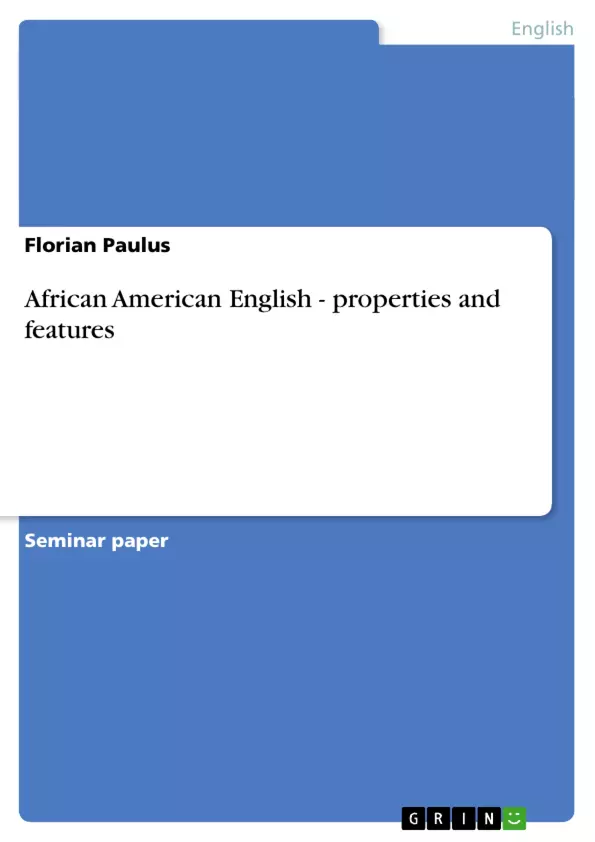Content
1. Introduction…………………………………………………………………...3
2. The roots of African American English……………………………………..3
3. Features……………………………………………………………………….5
3.1Phonetics……………………………………………………………………5
3.1.1.The “th” in AAE………………………………………………...5
3.1.2The Consonant Cluster education(CCR)…………...………..….7
3.2AAE as a non-rhotic dialect………..…………………………………...…9
3.3 Grammatical Features…………………………………………………......10
3.3.1Negation……………………………………………………...…10
3.3.2Time Reference……………………………………...…………11
3.4 BIN………………………………………………………………………12
4. Conclusion
5. Works cited
6. Appendix
2. The roots of African American English
Geneva Smitherman answers the question where the “black language and style” came from with the beginning of slavery in Colonial America. In 1619 a Dutch vessel brought with a cargo twenty Africans to Jamestown, Virginia to work there as “indentured servants”.
The blacks where mostly brought from countries of the African West Coast over the so called “West passage” to the Colonies in America. They were forced to work on the cash crop plantations, harvesting tobacco, cotton, Sugar and coffee.
Because there is, of course, no tape recordings of the language the slaves spoke, linguists have “to rely on reconstructions of black talk based on indirect evidence […] written reproductions of the dialect in Journals, letters and diaries by whites […].
African slaves developed a pidgin, what Smitherman calls a “language of transaction” used to communicate between themselves and the whites. This pidgin developed over the years as a widespread Creole among slaves. It consisted of the West-African words which were substituted little by little by English words but with the same basic language structures of West- African Languages. These Languages for example allow sentence constructions without the verb to be. According to that, sentences like “He going” still occur today in African American Vernacular English environments.
Because the American settlers did not speak Standard British English as they came from Ireland, Scotland, and Germany etc. the slaves adopted certain features of the pidgin the settlers spoke to their Creole. Especially in the South, where a lot of Irish settled, a typical feature of Irish phonology is wide spread.
Words like red and hat are pronounced with diphthongs, as “reɑd” and “həat”, respectively, which the blacks adopted to their language.
Inhaltsverzeichnis (Table of Contents)
- Introduction
- The roots of African American English
- Features
- Phonetics
- The “th” in AAE
- The Consonant Cluster education(CCR)
- AAE as a non-rhotic dialect
- Grammatical Features
- Negation
- Time Reference
- BIN
- Phonetics
Zielsetzung und Themenschwerpunkte (Objectives and Key Themes)
This paper aims to provide an overview of African American Vernacular English (AAE) by exploring its historical roots, prominent phonetic and grammatical features, and its evolution as a distinct linguistic variety. The paper also examines the role of AAE in shaping American English and its impact on contemporary language usage.
- The origins and development of AAE from its roots in African languages and its adaptation to the English language during the era of slavery in America.
- The distinctive phonetic features of AAE, including the pronunciation of the “th” sound and the consonant cluster reduction.
- The grammatical features of AAE, including the use of negation and time reference.
- The influence of AAE on American English, including the adoption of certain features into mainstream usage.
- The ongoing debate surrounding the status of AAE and its recognition as a legitimate linguistic variety.
Zusammenfassung der Kapitel (Chapter Summaries)
- Introduction: This chapter introduces the topic of African American Vernacular English (AAE) and provides context for the paper's focus on the language's origins, development, and key features. The author explains the rationale for selecting this topic and the approach taken in organizing the paper.
- The roots of African American English: This chapter traces the origins of AAE back to the period of slavery in Colonial America, examining the role of African languages and English in its formation. It explores the development of a pidgin language among slaves and its evolution into a Creole, emphasizing the influence of West African language structures.
- Features: This chapter delves into the prominent features of AAE, highlighting its distinctiveness from Standard American English. It discusses the phonetic features, including the pronunciation of the “th” sound and the consonant cluster reduction, and explores the grammatical features, such as negation and time reference.
Schlüsselwörter (Keywords)
African American Vernacular English, AAE, Pidgin, Creole, Phonetics, Grammar, Negation, Time Reference, Consonant Cluster Reduction, Linguistic Diversity, Language Variation.
- Citar trabajo
- Florian Paulus (Autor), 2008, African American English - properties and features, Múnich, GRIN Verlag, https://www.grin.com/document/90179



